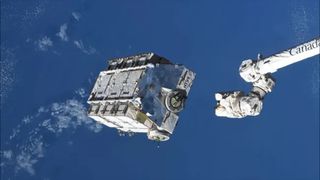An object that smashed through a Florida home was part of a pallet jettisoned from the International Space Station along with 5,800 pounds of aging batteries back in March 2021.

The mysterious object that crashed through the roof of a Florida home last month did indeed come from the International Space Station (ISS), NASA has confirmed.
That home, in the seaside city of Naples, belongs to Alejandro Otero. Shortly after the March 8 incident, Otero said he thought the offending object was part of a cargo pallet packed with 5,800 pounds (2,630 kilograms) of aging batteries jettisoned from the ISS in March 2021.
And he was right, according to a new NASA analysis of the object, which was performed at Florida’s Kennedy Space Center.
“Based on the examination, the agency determined the debris to be a stanchion from the NASA flight support equipment used to mount the batteries on the cargo pallet,” agency officials wrote in an update today (April 15).
Related: Sci-fi inspired tractor beams are real, and could solve a major space junk problem
The cylindrical piece of space junk is made of a metallic alloy called Inconel, they added. It weighs 1.6 pounds (0.7 kg) and measures 4 inches (10 centimeters) high by 1.6 inches (4 cm) wide.
The nickel-hydride batteries were dumped after new lithium-ion versions were delivered to the ISS for a power-supply upgrade. The pallet and the batteries were expected to burn up completely in Earth’s atmosphere, NASA officials said in today’s update — yet that didn’t happen, and the agency wants to learn why.
window.sliceComponents = window.sliceComponents || {};
externalsScriptLoaded.then(() => {
window.reliablePageLoad.then(() => {
var componentContainer = document.querySelector(“#slice-container-newsletterForm-articleInbodyContent-kmTbkVQXhToBv6QNvSYhLo”);
if (componentContainer) {
var data = {“layout”:”inbodyContent”,”header”:”Sign up for the Live Science daily newsletter now”,”tagline”:”Get the worldu2019s most fascinating discoveries delivered straight to your inbox.”,”formFooterText”:”By submitting your information you agree to the Terms & Conditions and Privacy Policy and are aged 16 or over.”,”successMessage”:{“body”:”Thank you for signing up. You will receive a confirmation email shortly.”},”failureMessage”:”There was a problem. Please refresh the page and try again.”,”method”:”POST”,”inputs”:[{“type”:”hidden”,”name”:”NAME”},{“type”:”email”,”name”:”MAIL”,”placeholder”:”Your Email Address”,”required”:true},{“type”:”hidden”,”name”:”NEWSLETTER_CODE”,”value”:”XLS-D”},{“type”:”hidden”,”name”:”LANG”,”value”:”EN”},{“type”:”hidden”,”name”:”SOURCE”,”value”:”60″},{“type”:”hidden”,”name”:”COUNTRY”},{“type”:”checkbox”,”name”:”CONTACT_OTHER_BRANDS”,”label”:{“text”:”Contact me with news and offers from other Future brands”}},{“type”:”checkbox”,”name”:”CONTACT_PARTNERS”,”label”:{“text”:”Receive email from us on behalf of our trusted partners or sponsors”}},{“type”:”submit”,”value”:”Sign me up”,”required”:true}],”endpoint”:”https://newsletter-subscribe.futureplc.com/v2/submission/submit”,”analytics”:[{“analyticsType”:”widgetViewed”}],”ariaLabels”:{}};
var triggerHydrate = function() {
window.sliceComponents.newsletterForm.hydrate(data, componentContainer);
}
if (window.lazyObserveElement) {
window.lazyObserveElement(componentContainer, triggerHydrate);
} else {
triggerHydrate();
}
}
}).catch(err => console.log(‘Hydration Script has failed for newsletterForm-articleInbodyContent-kmTbkVQXhToBv6QNvSYhLo Slice’, err));
}).catch(err => console.log(‘Externals script failed to load’, err));

“The International Space Station will perform a detailed investigation of the jettison and reentry analysis to determine the cause of the debris survival and to update modeling and analysis, as needed,” NASA officials wrote in today’s update.
“NASA specialists use engineering models to estimate how objects heat up and break apart during atmospheric reentry,” they added. “These models require detailed input parameters and are regularly updated when debris is found to have survived atmospheric reentry to the ground.”
Otero’s experience serves as a reminder that there’s a tremendous amount of hardware whizzing over our heads.
And, as has been demonstrated, some of this junk comes crashing back to Earth from time to time. For instance, the 23-ton core stages of China’s powerful Long March 5B rocket routinely fall in an uncontrolled fashion a week or so after their launches, to the consternation of the international space community.
NASA’s new analysis may have financial consequences for the agency and for Otero, by the way.
“I eagerly await communication from the responsible agencies, as their assistance is crucial in resolving the damages from this deliberate release. But more importantly how in the future to arrange the payload so it will burn in its entirety as it reenters,” Otero wrote via X on March 8, shortly after his home was hit.
Originally posted on Space.com.

READ MORE
Graphene can be used to detect COVID-19 quickly, accurately
An illustration of the graphene-based COVID-19 spike protein detection process developed at UIC. The white [...]
Listening to the Big Bang
Less than a mile from the South Pole, the Dark Sector Lab’s Bicep2 telescope (at [...]
How To Maximize Your Gameplay: Leveraging AI Strategies for Online Gaming Success
In the fast-paced world of online gaming, staying ahead of the competition requires more than [...]
To Pinpoint the Origin of a Fish, Check Out Its Physique
A fisher from a small-scale fishery in Honduras hooks a yellowtail snapper—a species of fish [...]
Highlighting an ‘innovative approach’ to research into 2D materials
BEXP sample preparation process. a) The sample containing the flake of interest is placed on [...]
New nanomechanical oscillators with record-low loss
Scanning electron micrograph of a polygon resonator. The inset shows the shape of the perimeter [...]
Color Wheel Theory: How to Talk About Color
The 12-color wheel used in modern color theory is basically the same as the one [...]
Visible hydrogels for rapid hemorrhage control and monitoring
Credit: Terasaki Institute for Biomedical Innovation There are many different events which may lead to [...]